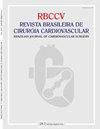应用三氯生浸渍Polyglastin缝线预防冠状动脉旁路移植术中输卵管切除术伤口感染的效果:一项前瞻性、双盲、随机临床试验
IF 1.1
4区 医学
Q4 CARDIAC & CARDIOVASCULAR SYSTEMS
Revista Brasileira De Cirurgia Cardiovascular
Pub Date : 2019-12-01
DOI:10.21470/1678-9741-2019-0048
引用次数: 5
摘要
目的评价三氯生包被缝线对冠状动脉搭桥术(CABG)患者隐骨切除术创面减少感染的效果。方法2011年2月至2014年6月,采用前瞻性、随机、双盲研究方法,对508例行隐管切除术的CABG患者进行研究。患者随机分为三氯生包被缝合组(251例)和常规非抗生素缝合组(257例)。测量和分析人口统计学(性别和年龄)、临床(体重指数、糖尿病和镇痛药的使用)和术中(体外循环和交叉钳夹次数)变量以及与隐骨切除术伤口相关的变量(疼痛、裂开、红斑、感染、坏死和高热)。结果508例行隐骨切除术的患者中,男性占69.9%,糖尿病占40.2%。感染33例(6.5%),三氯生组13例(5.3%),常规缝合组20例(7.9%)(P=0.281)。204例糖尿病患者中,使用三氯生缝线的占45.1%,感染4例;54.9%采用常规缝合,11例感染。大多数患者(94.3%)接受了非泵式冠脉搭桥。三氯生包覆缝线组伤口疼痛发生率为9.9%,常规缝线组为17.9% (P=0.011)。使用三氯生包覆缝线的患者有1.6%的伤口高热,而使用常规缝线的患者有5.4%的伤口高热(P=0.028)。结论三氯生包被缝线在冠脉搭桥患者隐骨切除术中感染率较低,但差异无统计学意义。与常规缝合线相比,三氯生包覆缝合线患者疼痛和伤口高热发生率较低。本文章由计算机程序翻译,如有差异,请以英文原文为准。
Effect of Using Triclosan-Impregnated Polyglactin Suture to Prevent Infection of Saphenectomy Wounds in CABG: A Prospective, Double-Blind, Randomized Clinical Trial
Objective To evaluate the efficacy of triclosan-coated suture for the reduction of infection in saphenectomy wounds of patients undergoing coronary artery bypass graft (CABG) surgery. Methods A total of 508 patients who underwent saphenectomy in CABG surgery were included in a prospective, randomized, double-blind trial from February/2011 to June/2014. Patients were randomized into the triclosan-coated suture group (n= 251) and the conventional non-antibiotic suture group (n=257). Demographic (gender and age), clinical (body mass index, diabetes, and use of analgesics), and intraoperative (cardiopulmonary bypass and cross-clamp times) variables and those related to the saphenectomy wound (pain, dehiscence, erythema, infection, necrosis, and hyperthermia) were measured and analyzed. Results Of the 508 patients who underwent saphenectomy, 69.9% were males and 40.2% were diabetic. Thirty-three (6.5%) patients presented infection: 13 (5.3%) with triclosan and 20 (7.9%) with conventional suture (P=0.281). Among diabetic patients (n=204), triclosan suture was used in 45.1% with four cases of infection; conventional suture was used in 54.9% of them, with 11 cases of infection. Most patients (94.3%) underwent on-pump CABG. Wound pain was observed in 9.9% of patients with triclosan-coated suture and in 17.9% with conventional suture (P=0.011). Wound hyperthermia was found in 1.6% of patients with triclosan-coated suture and in 5.4% of those with conventional suture (P=0.028). Conclusion Triclosan-coated suture shows lower infection rate in saphenectomy of patients undergoing CABG, although the differences were not statistically significant. Pain and wound hyperthermia were less frequent in patients with triclosan-coated sutures compared with conventional sutures.
求助全文
通过发布文献求助,成功后即可免费获取论文全文。
去求助
来源期刊

Revista Brasileira De Cirurgia Cardiovascular
CARDIAC & CARDIOVASCULAR SYSTEMS-SURGERY
CiteScore
2.10
自引率
0.00%
发文量
176
审稿时长
20 weeks
期刊介绍:
Brazilian Journal of Cardiovascular Surgery (BJCVS) is the official journal of the Brazilian Society of Cardiovascular Surgery (SBCCV). BJCVS is a bimonthly, peer-reviewed scientific journal, with regular circulation since 1986.
BJCVS aims to record the scientific and innovation production in cardiovascular surgery and promote study, improvement and professional updating in the specialty. It has significant impact on cardiovascular surgery practice and related areas.
 求助内容:
求助内容: 应助结果提醒方式:
应助结果提醒方式:


